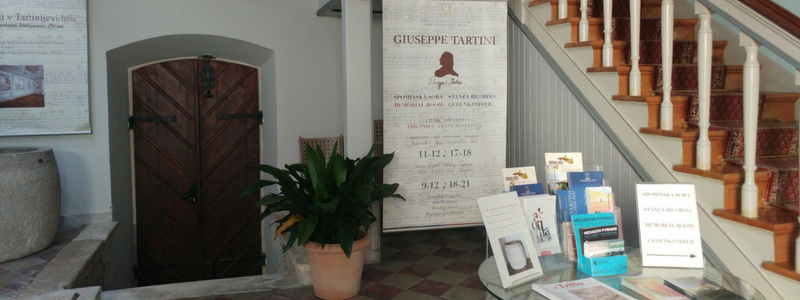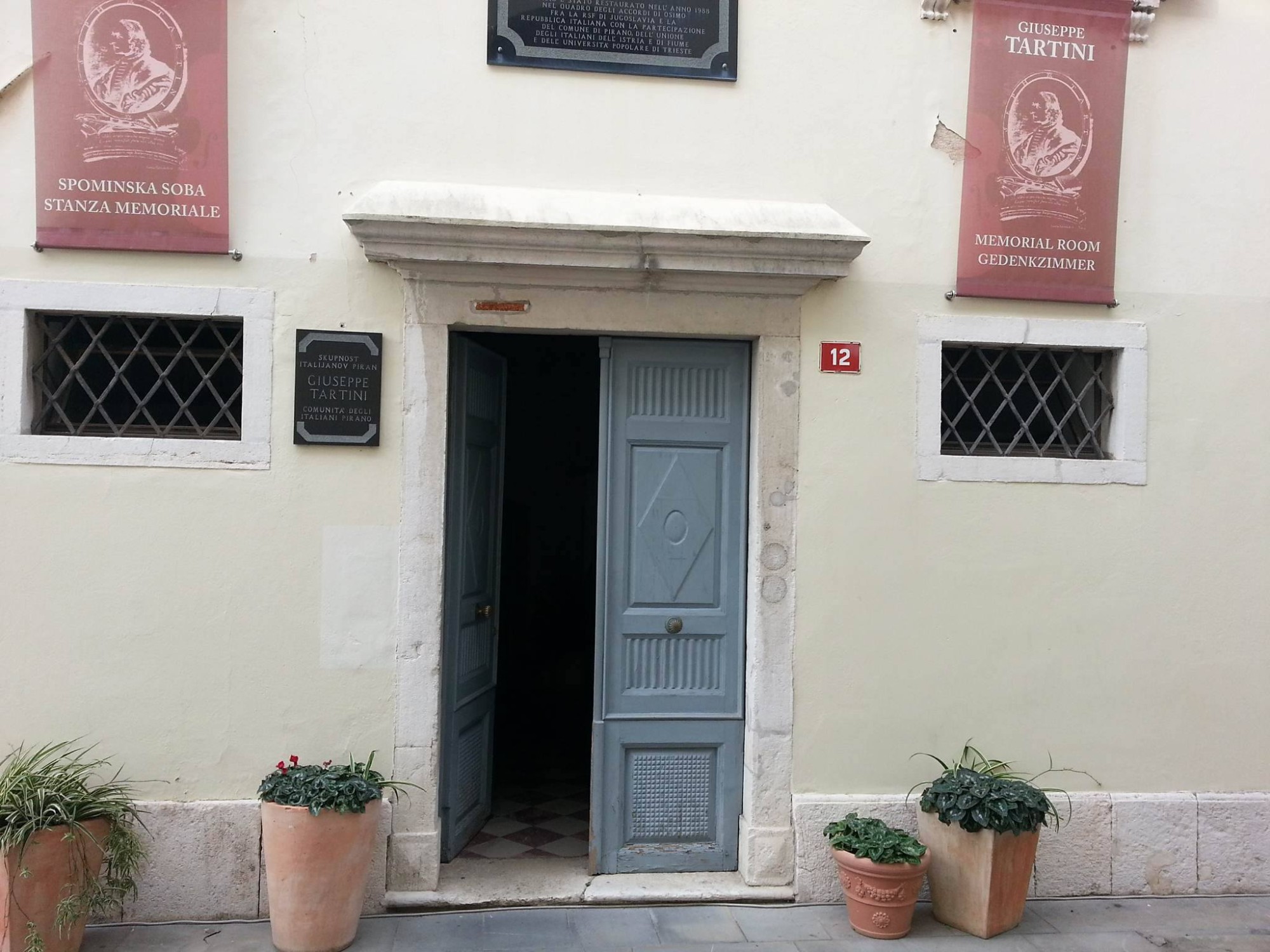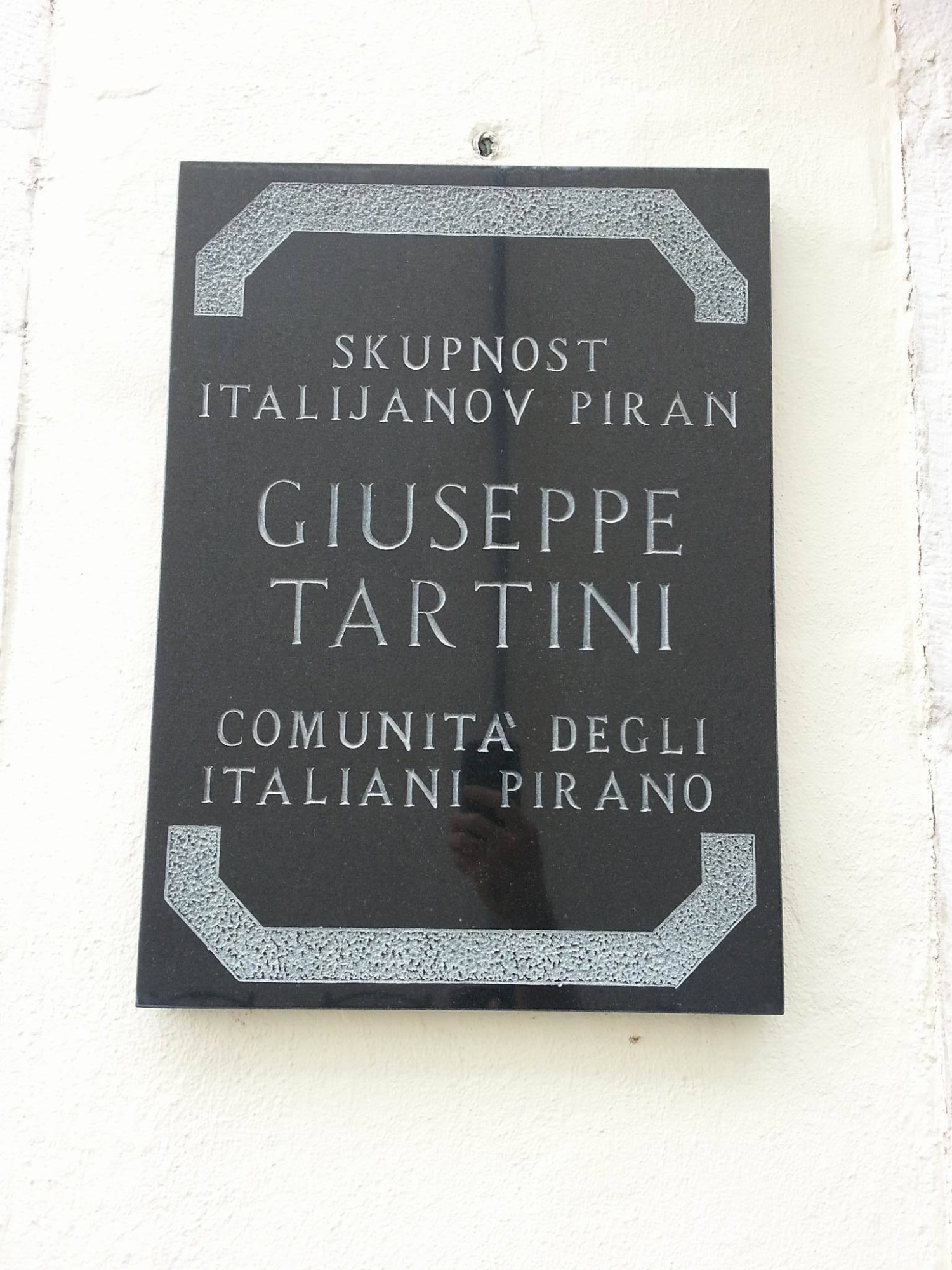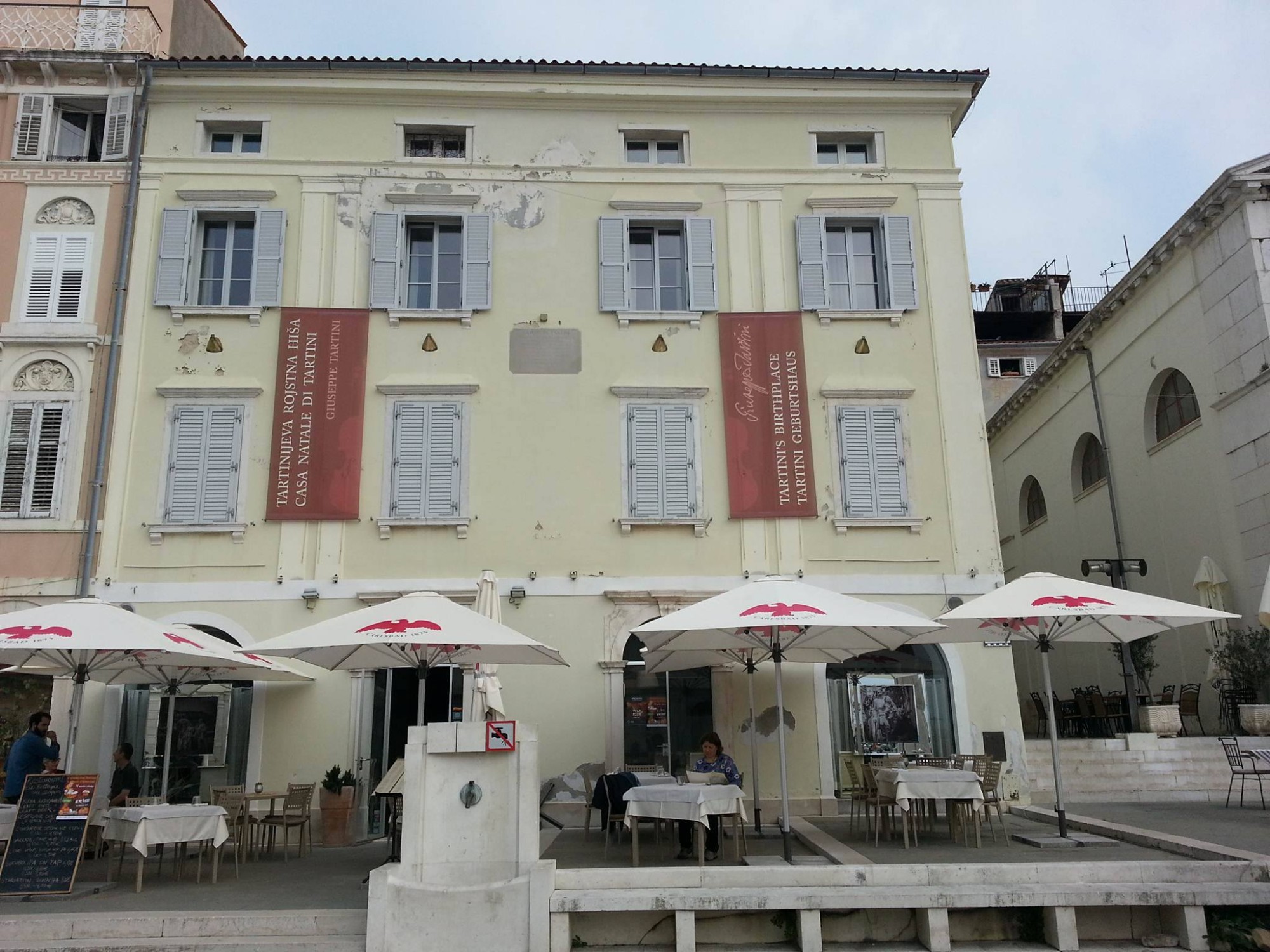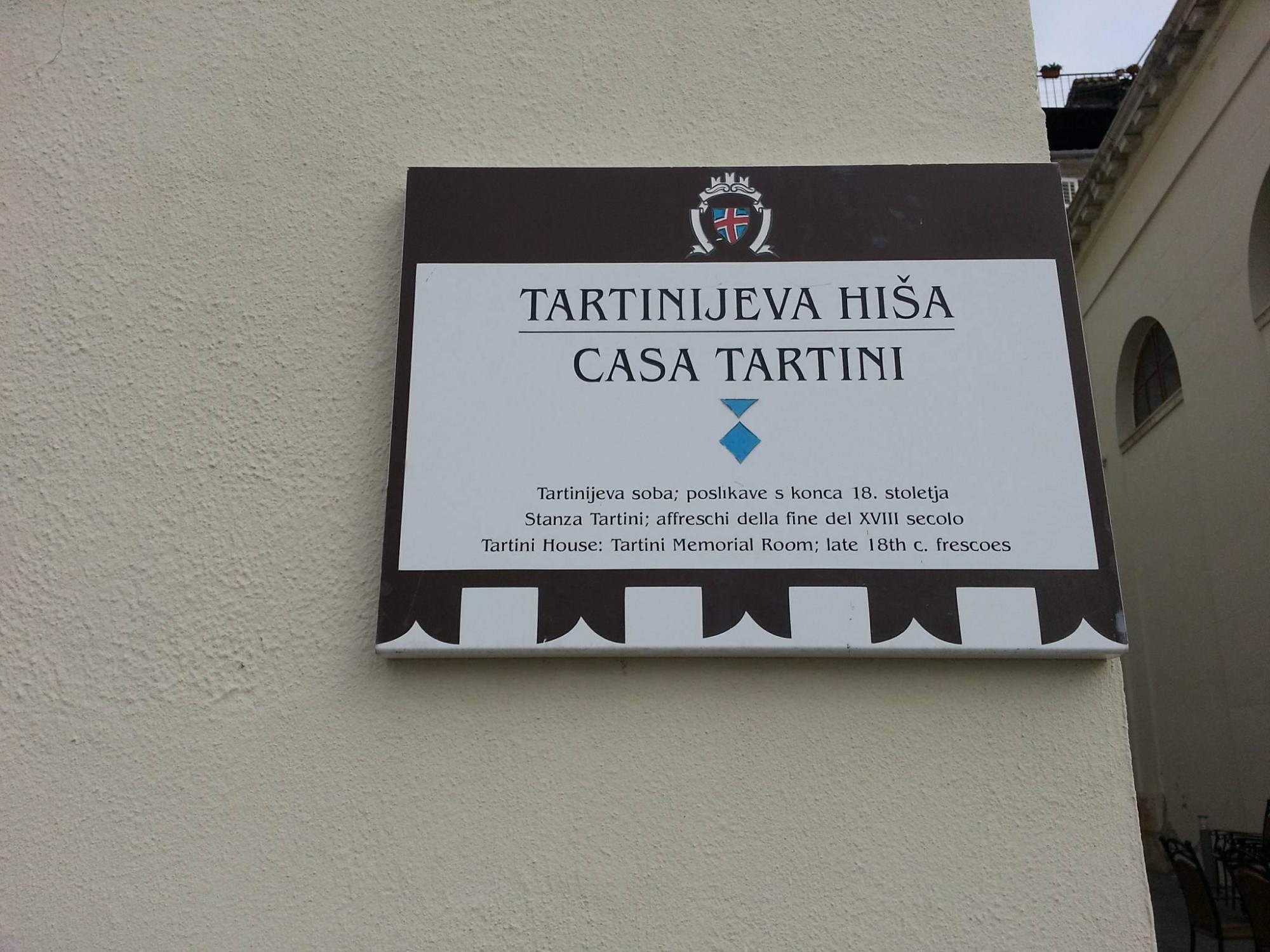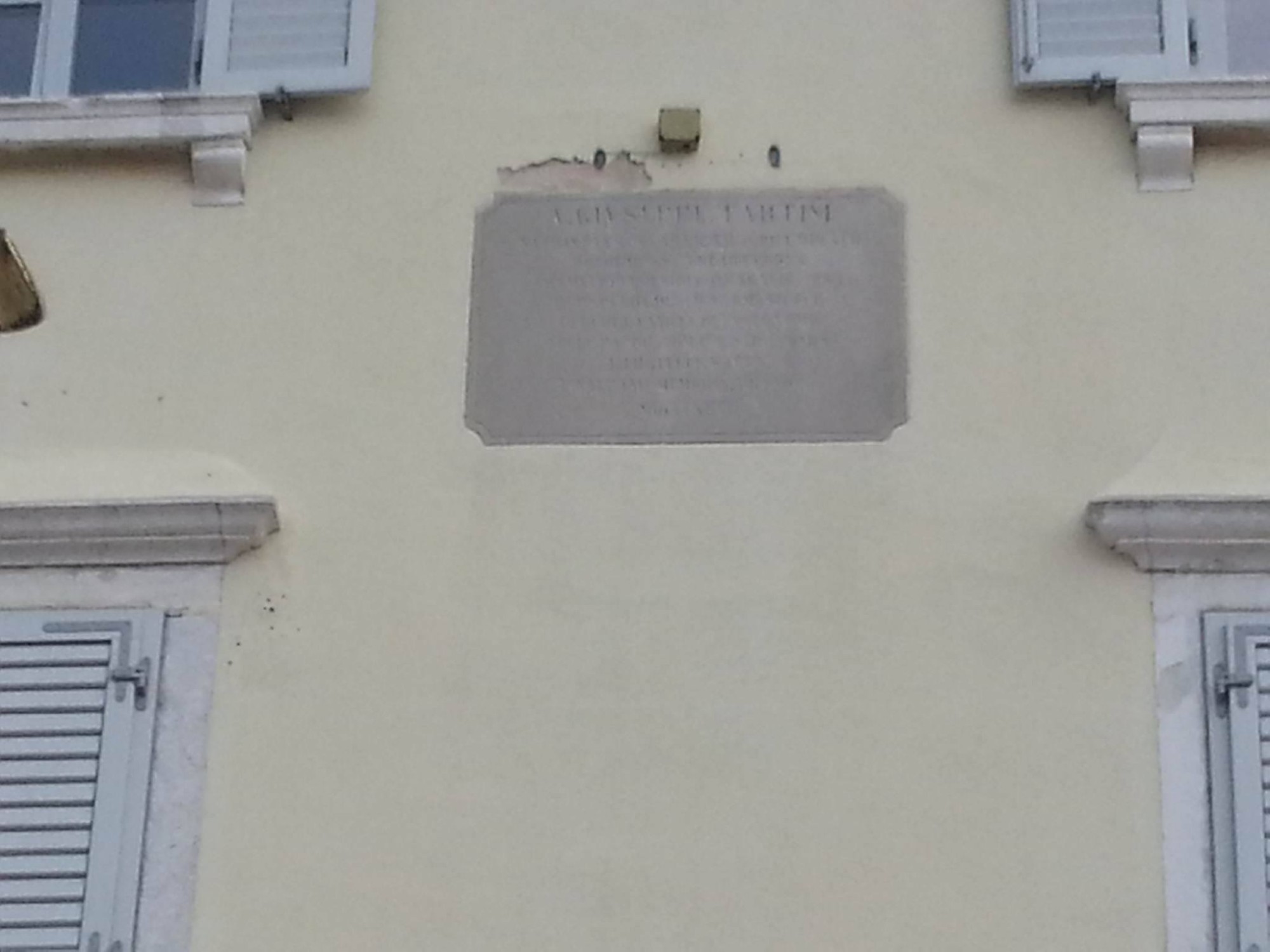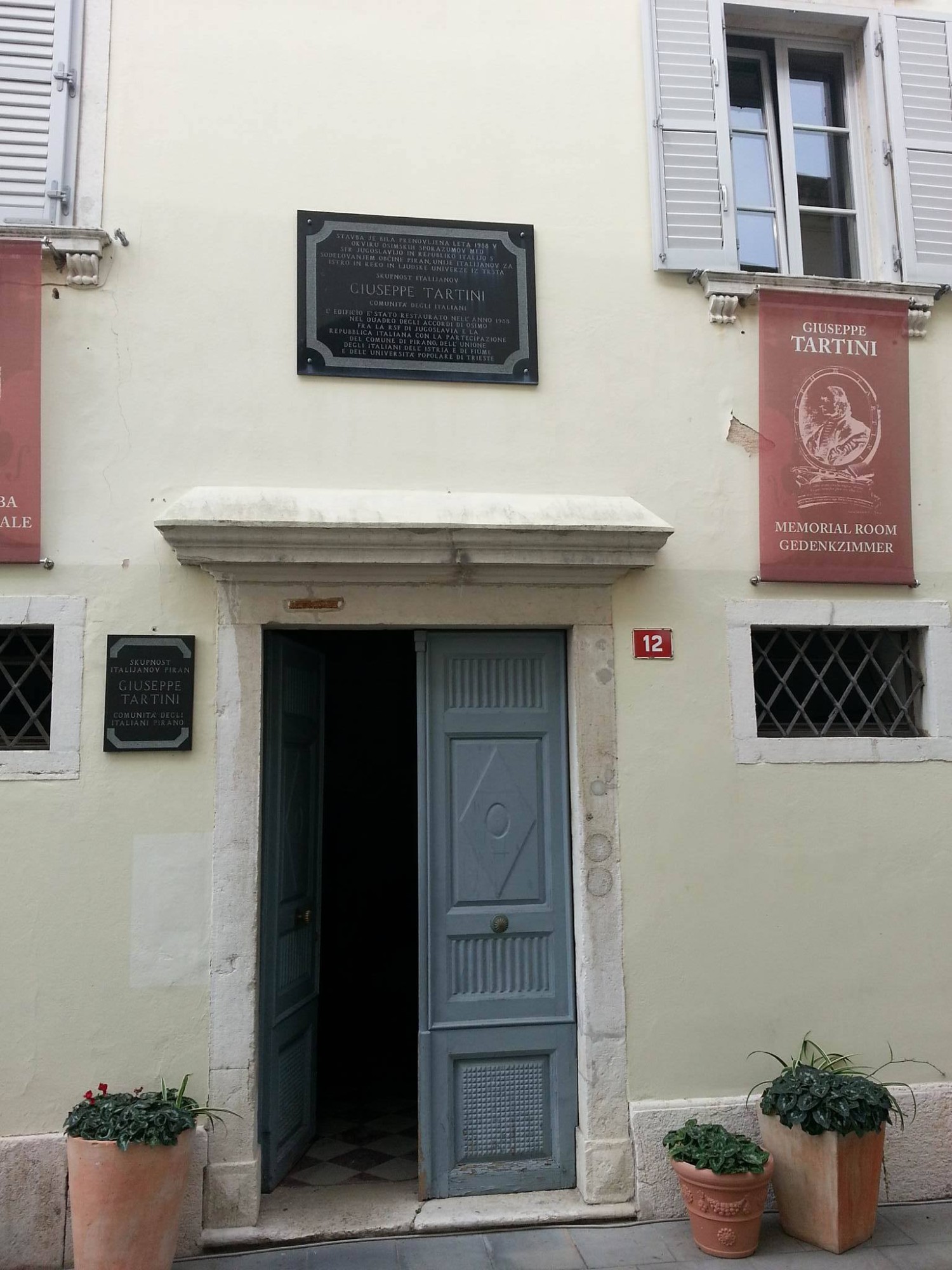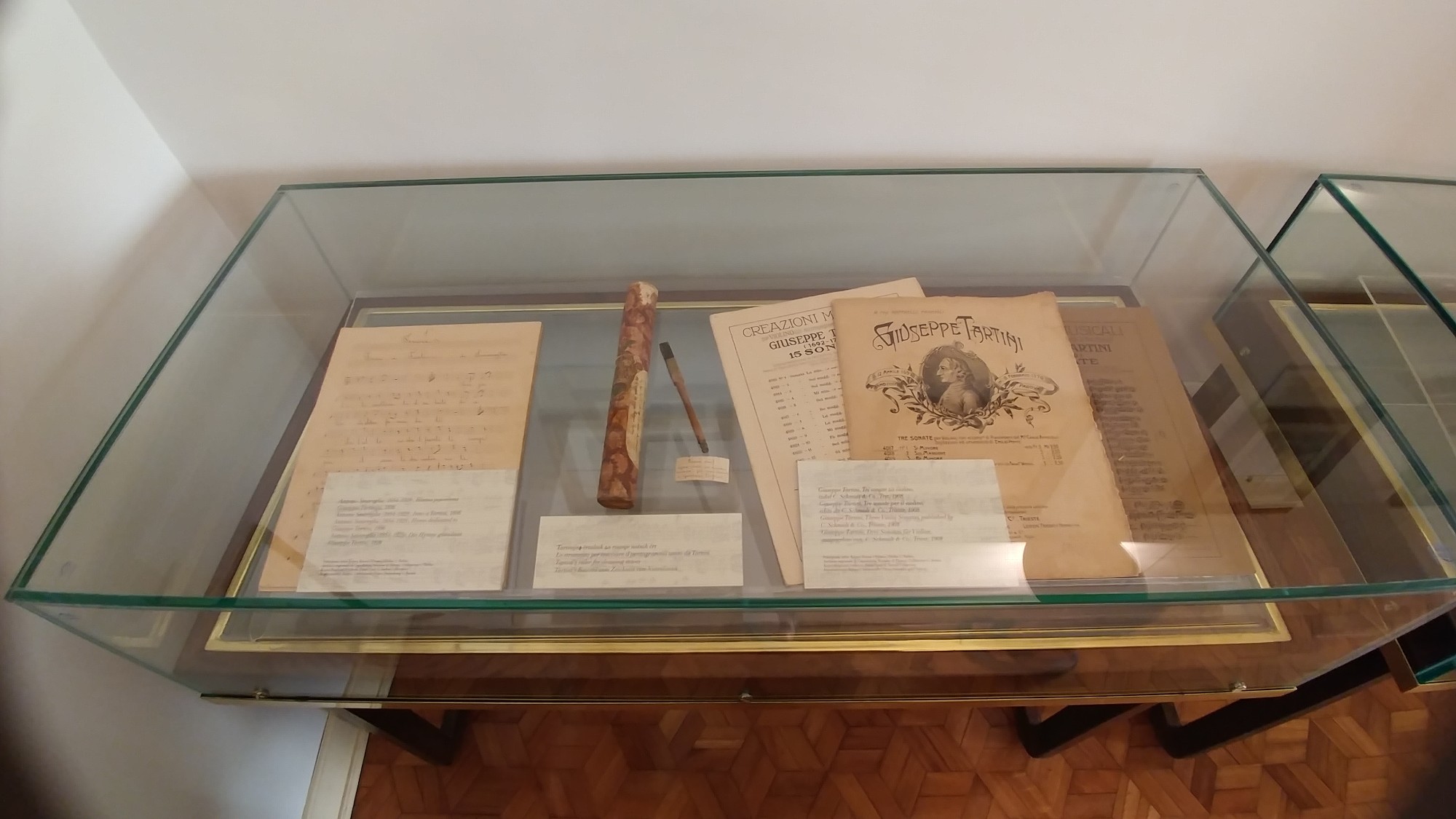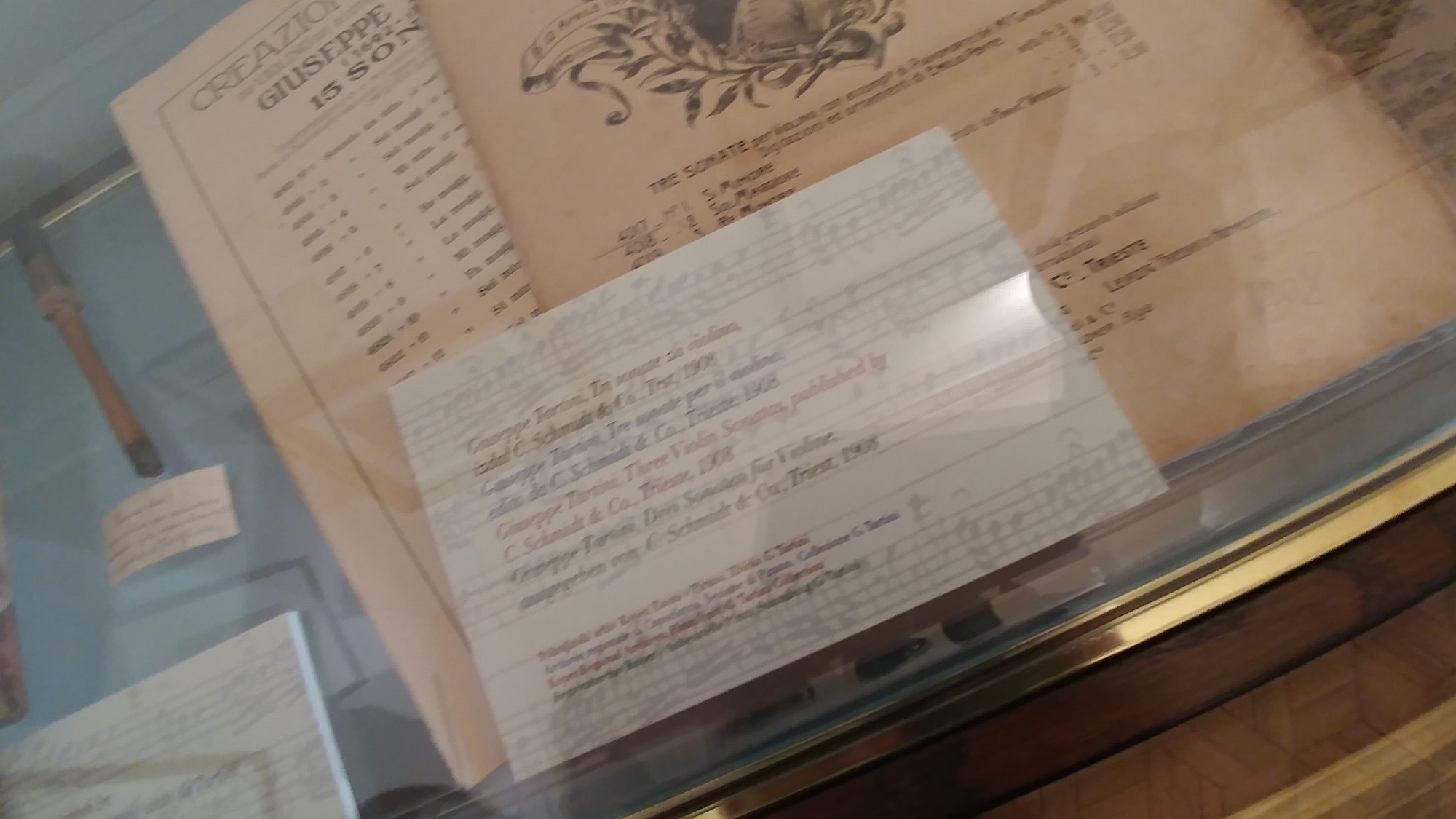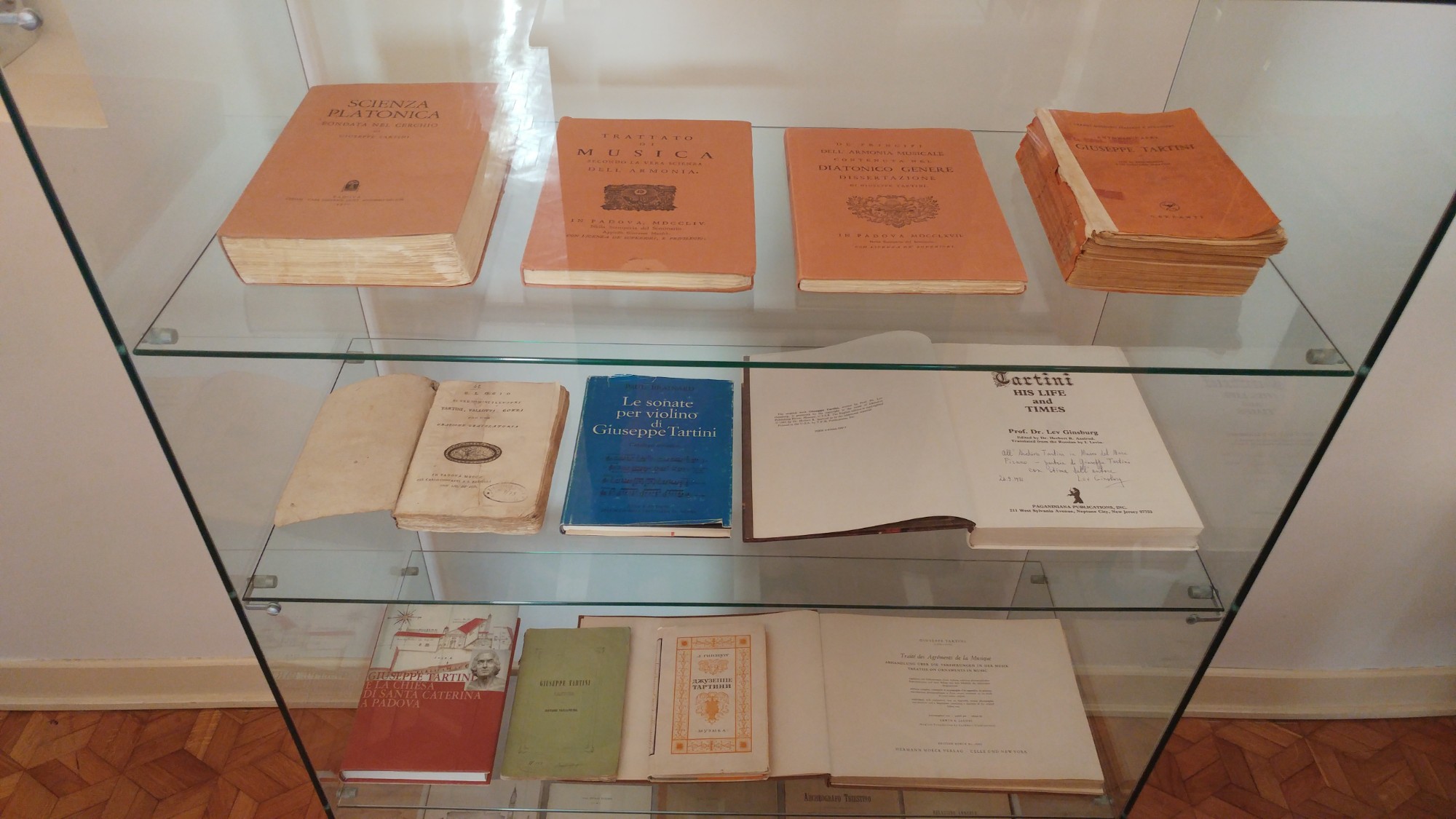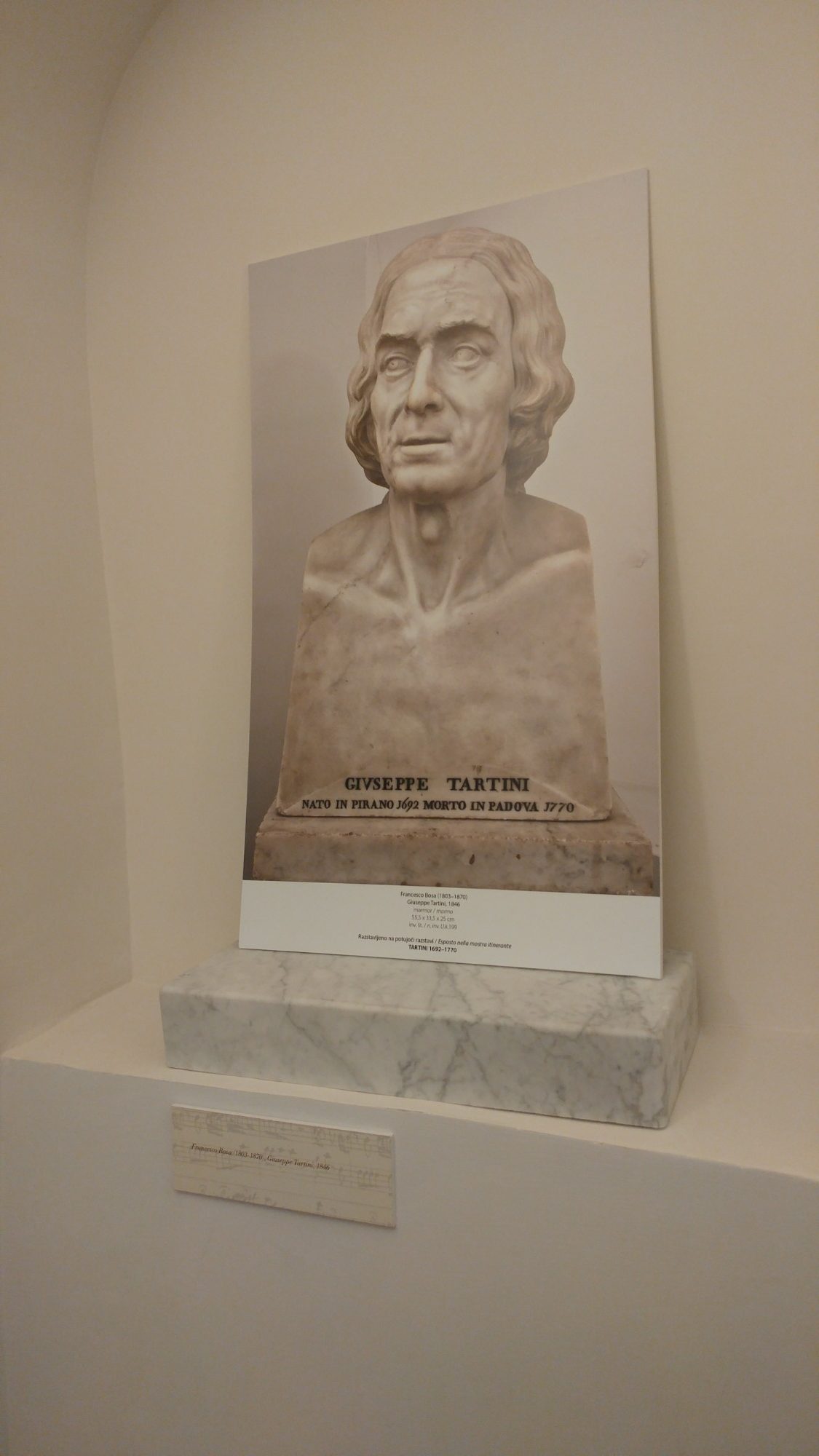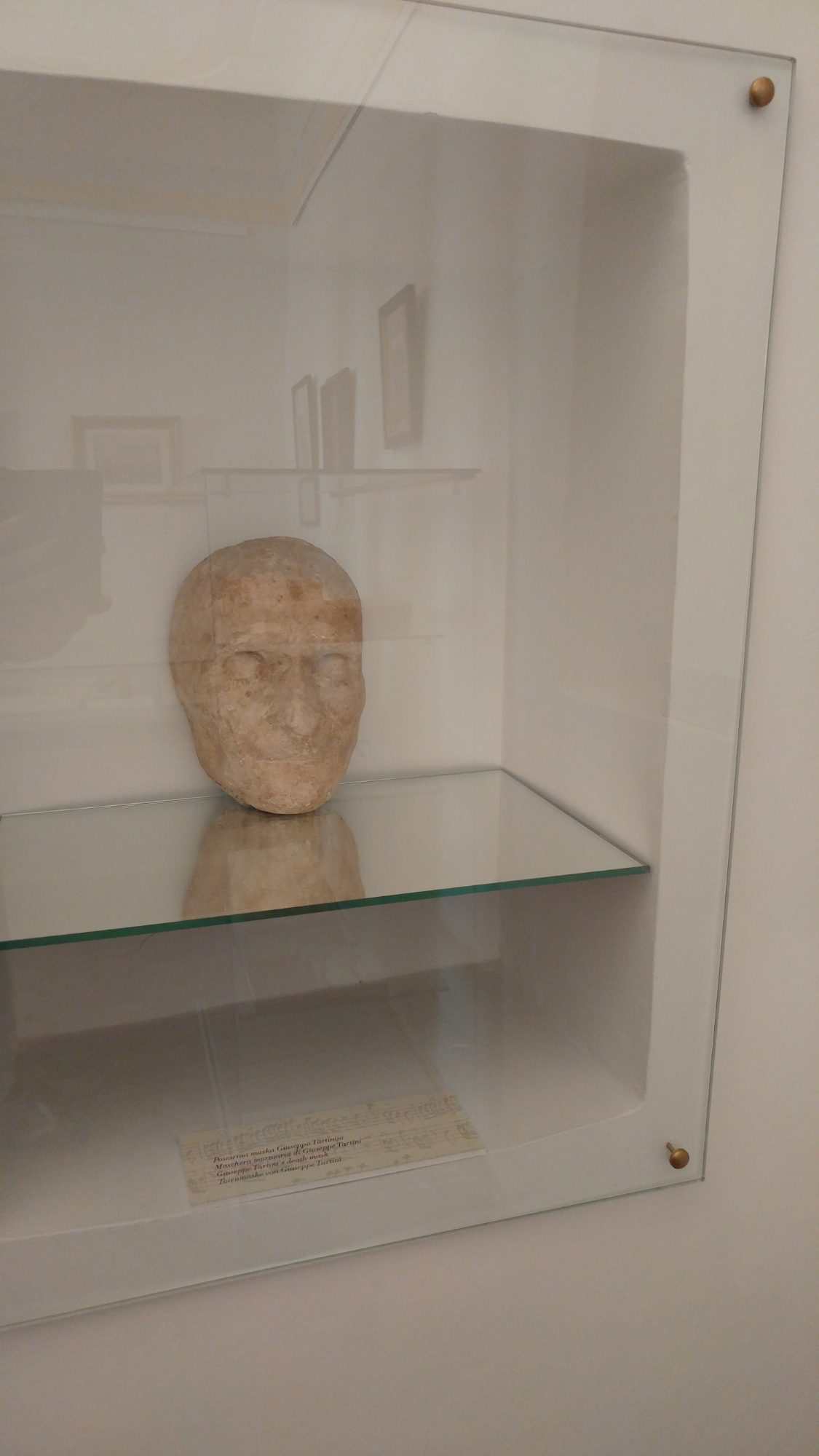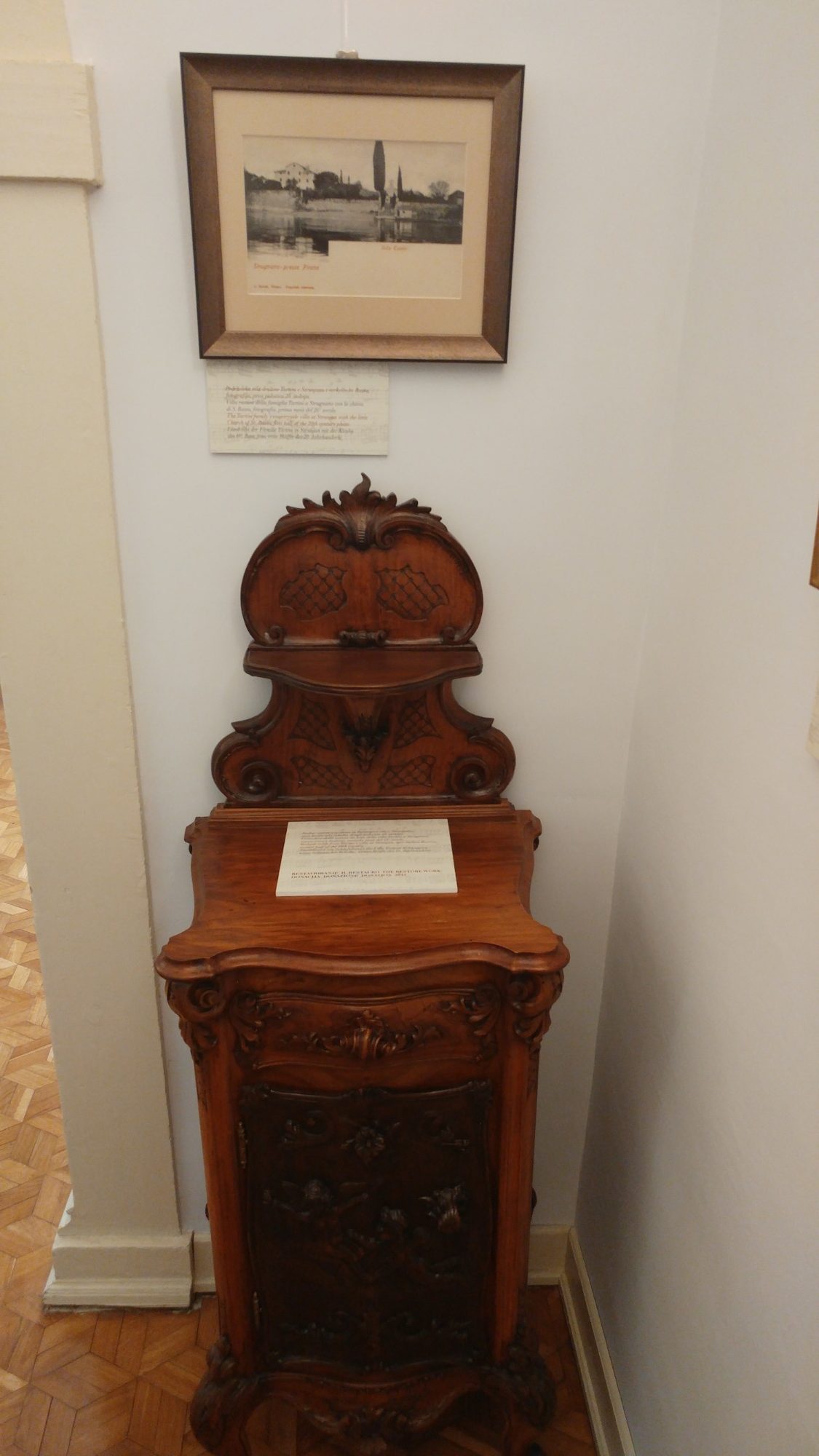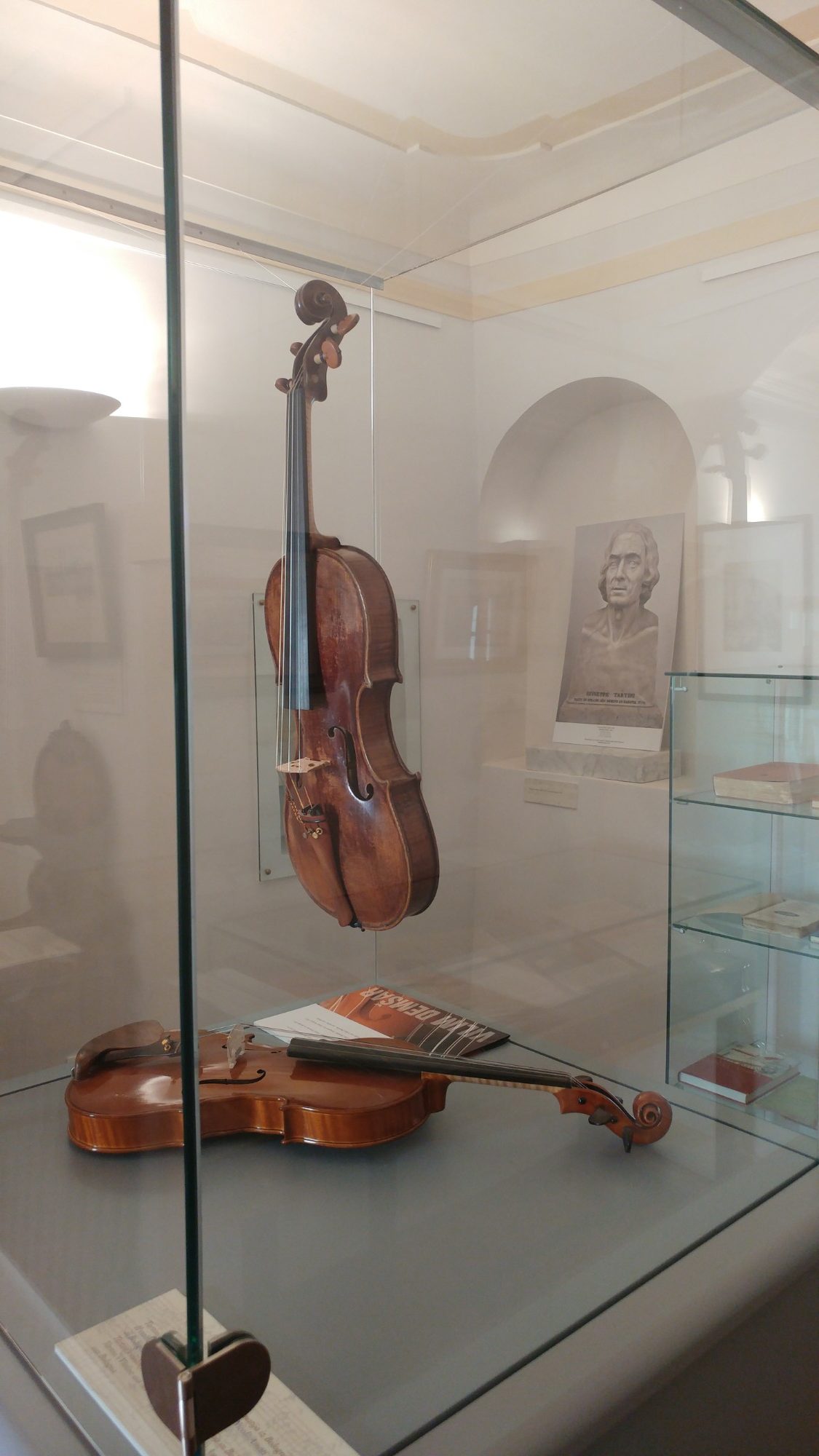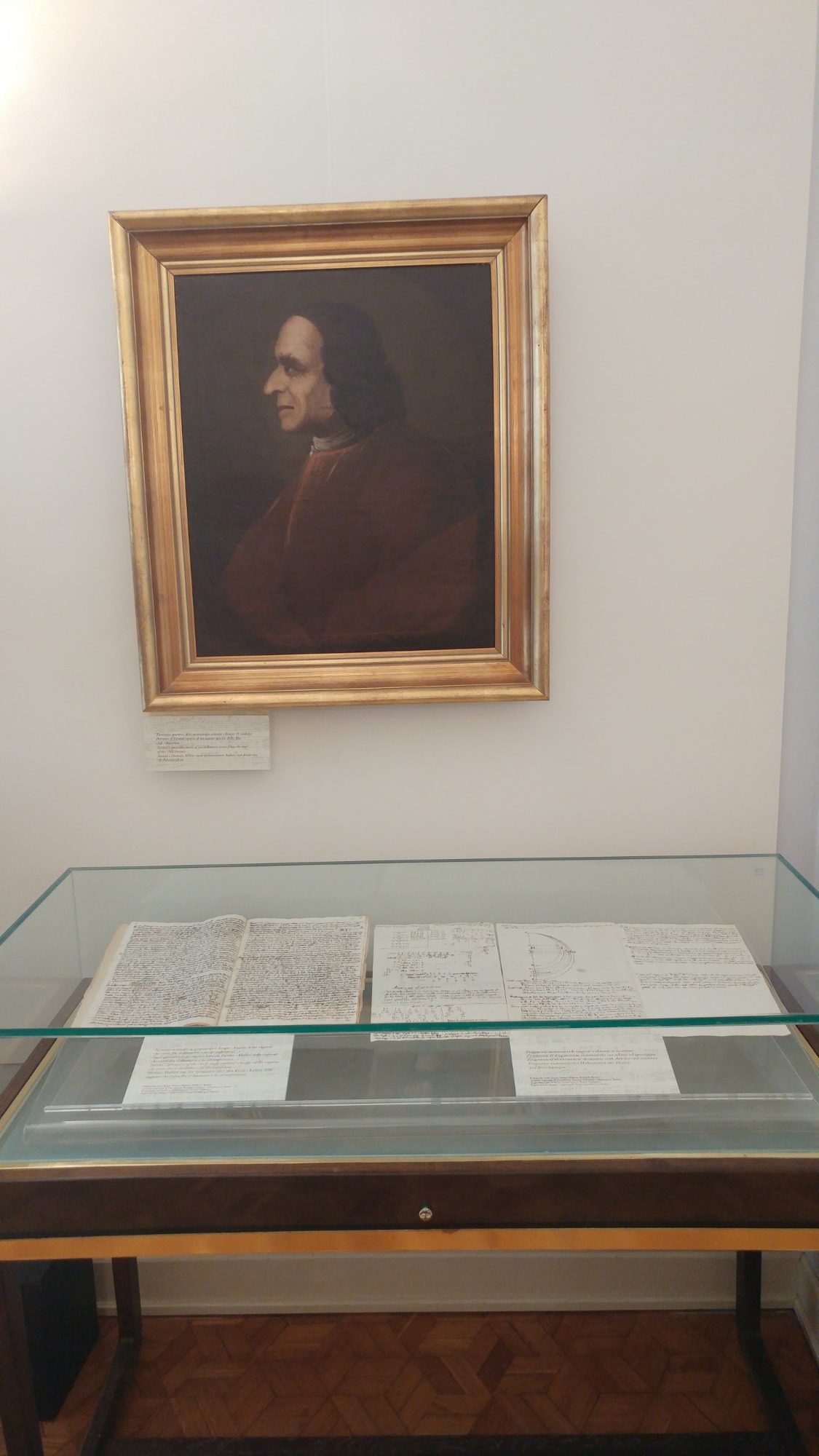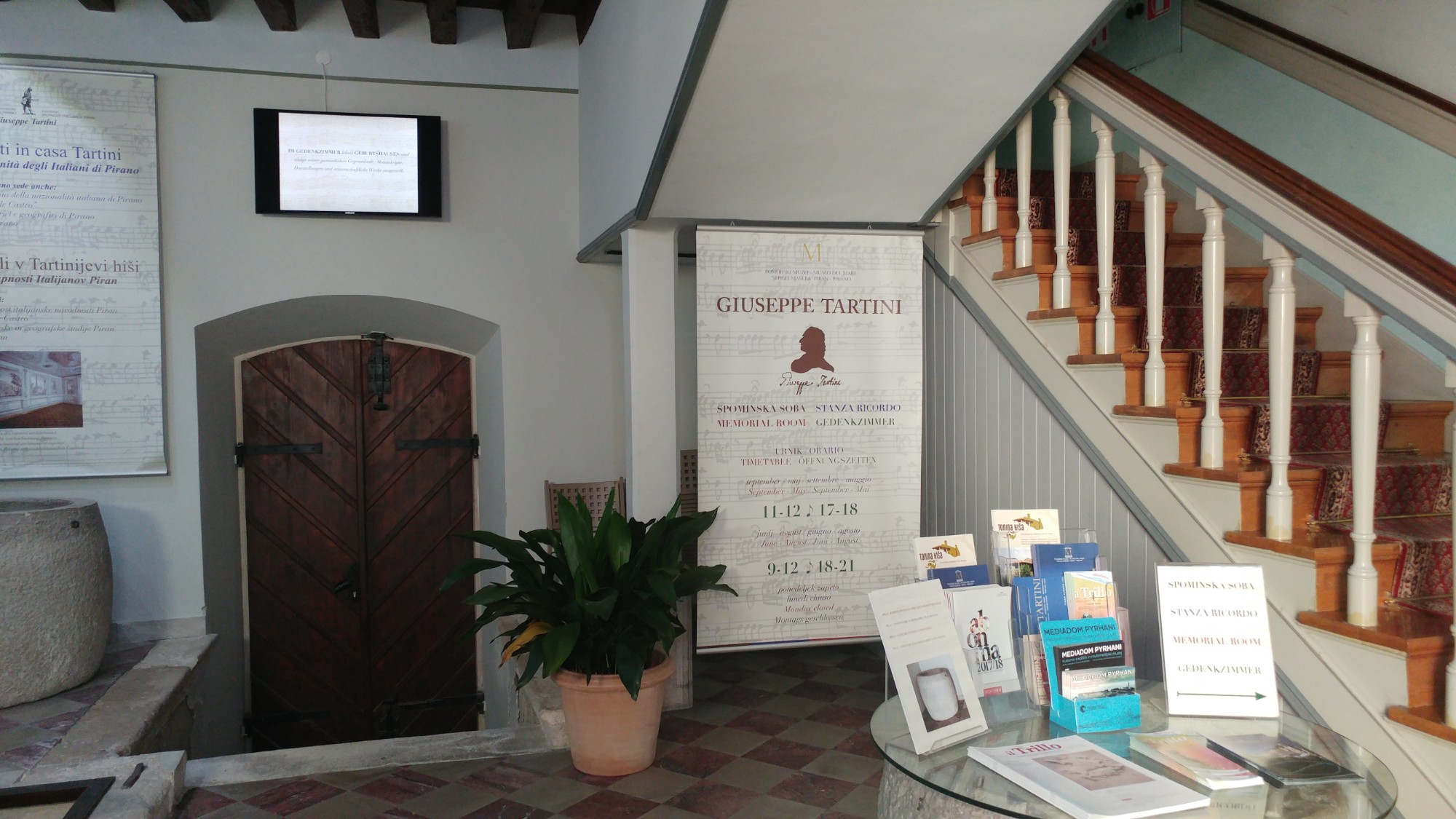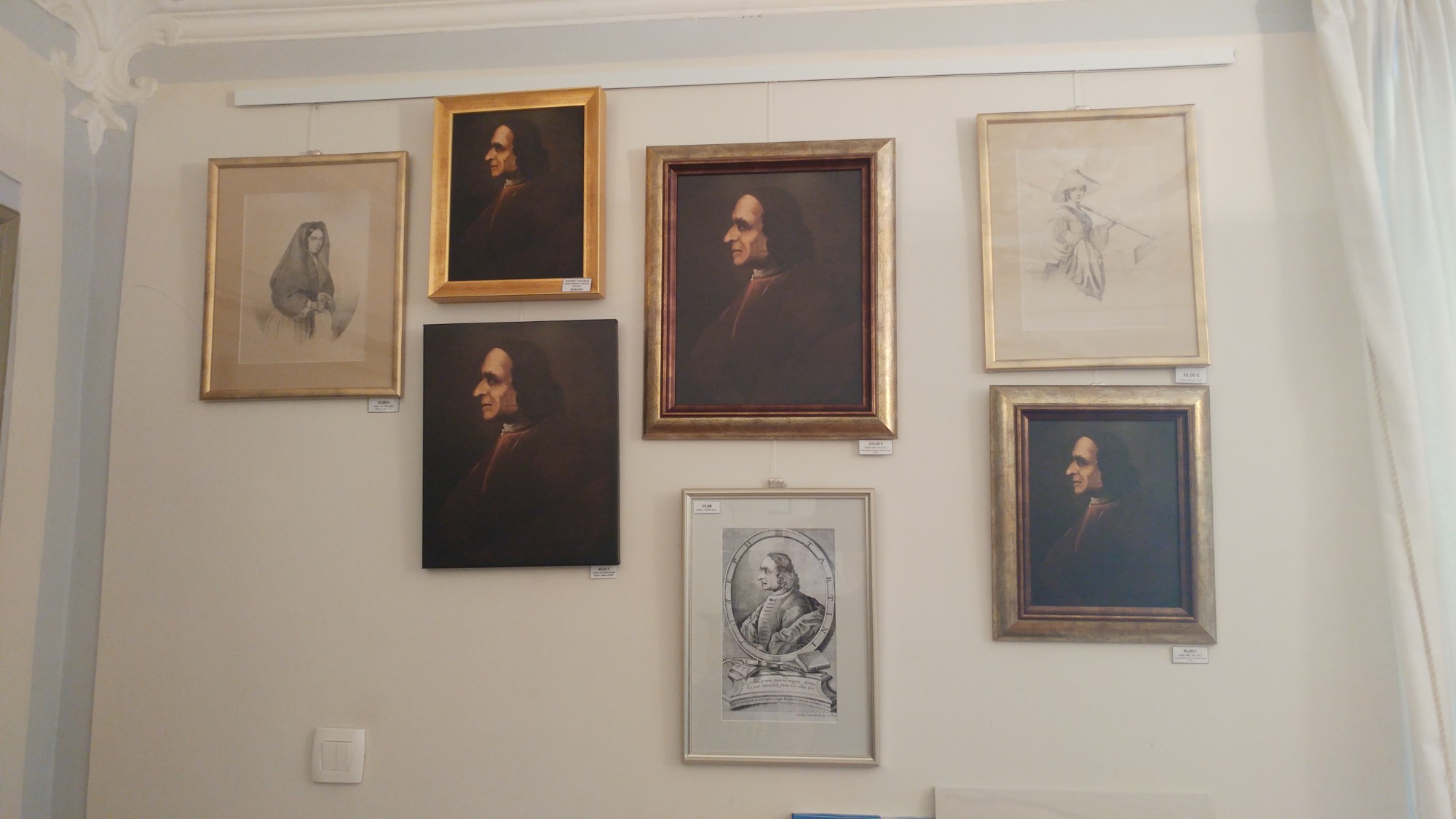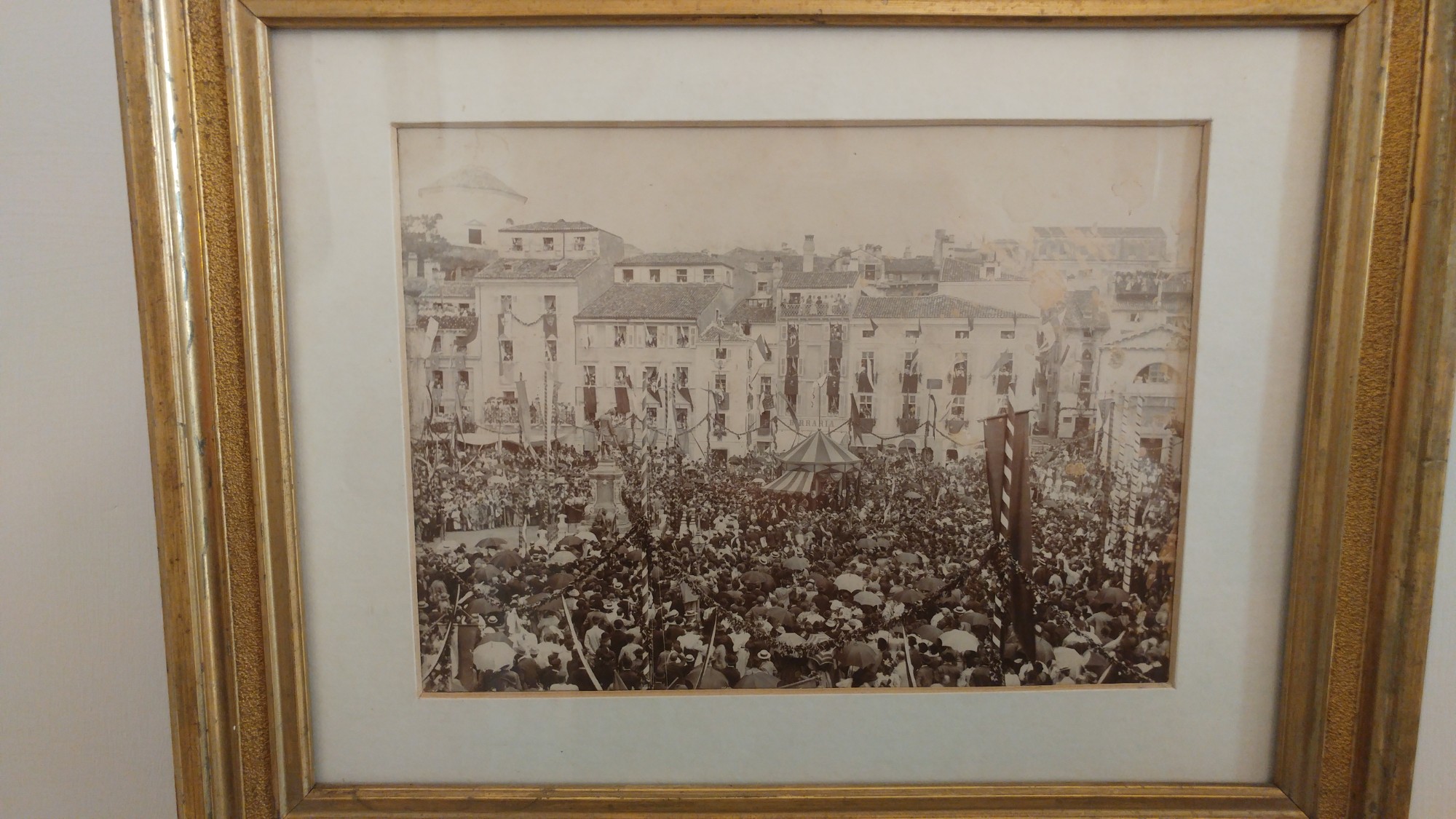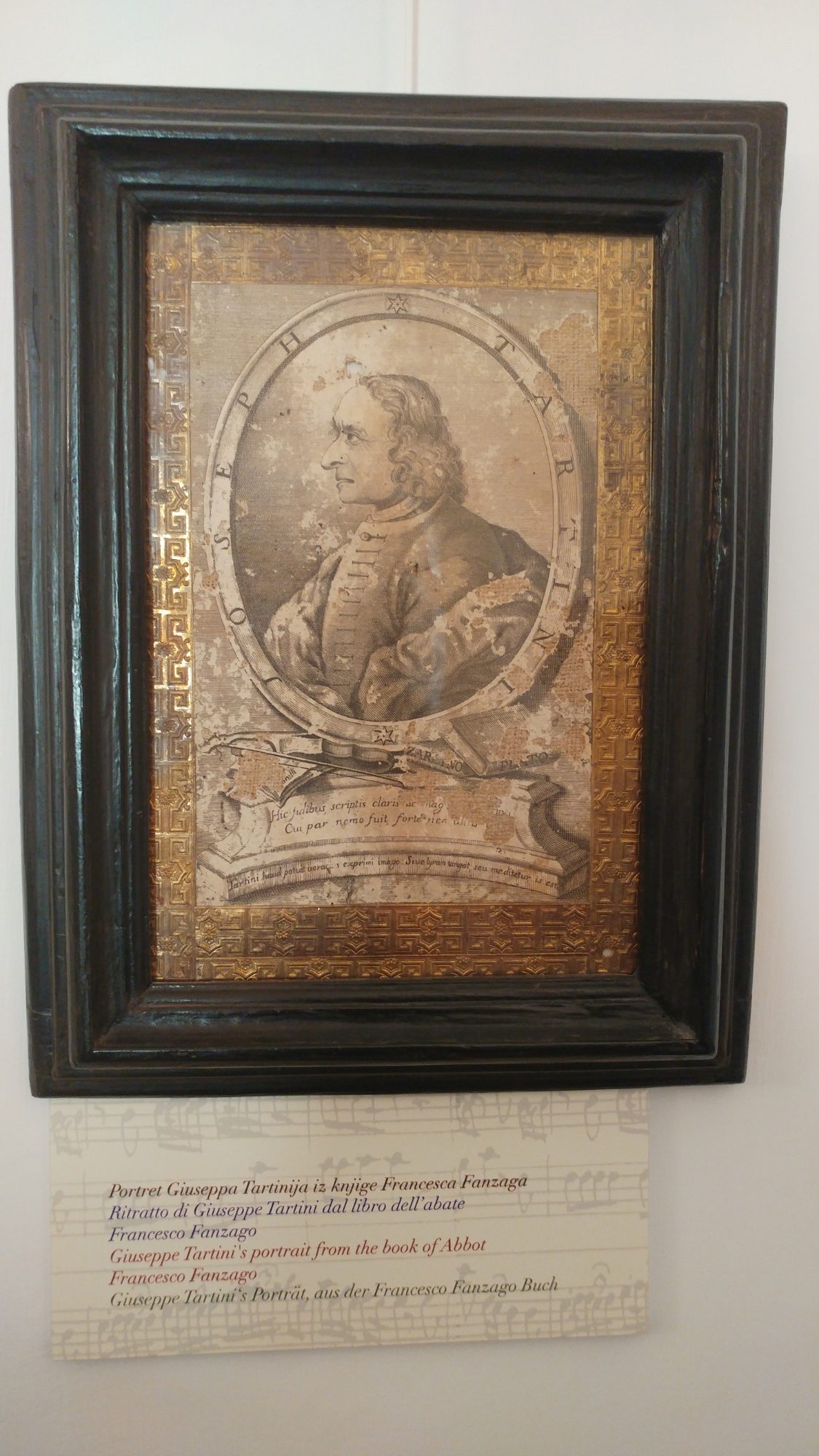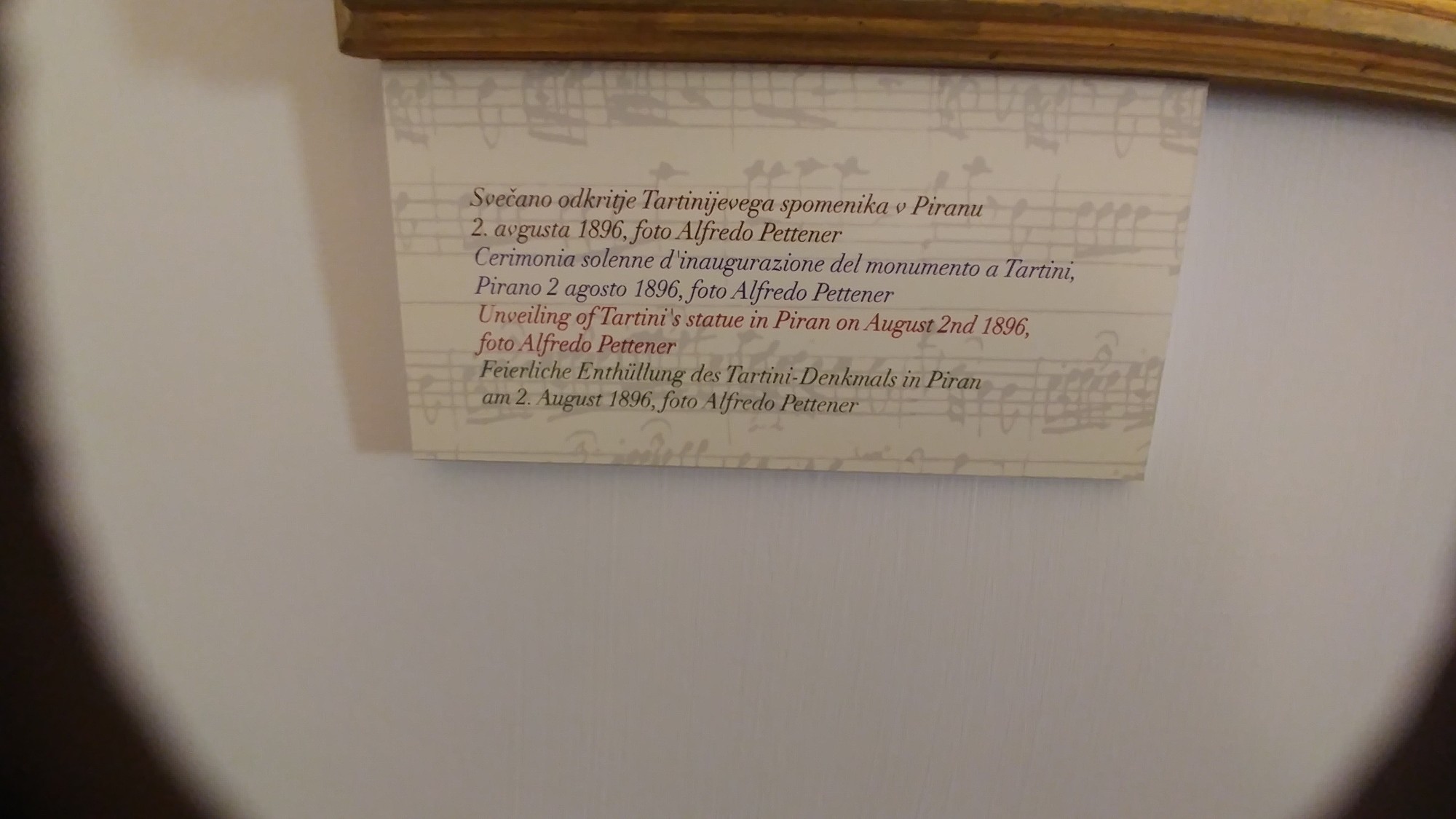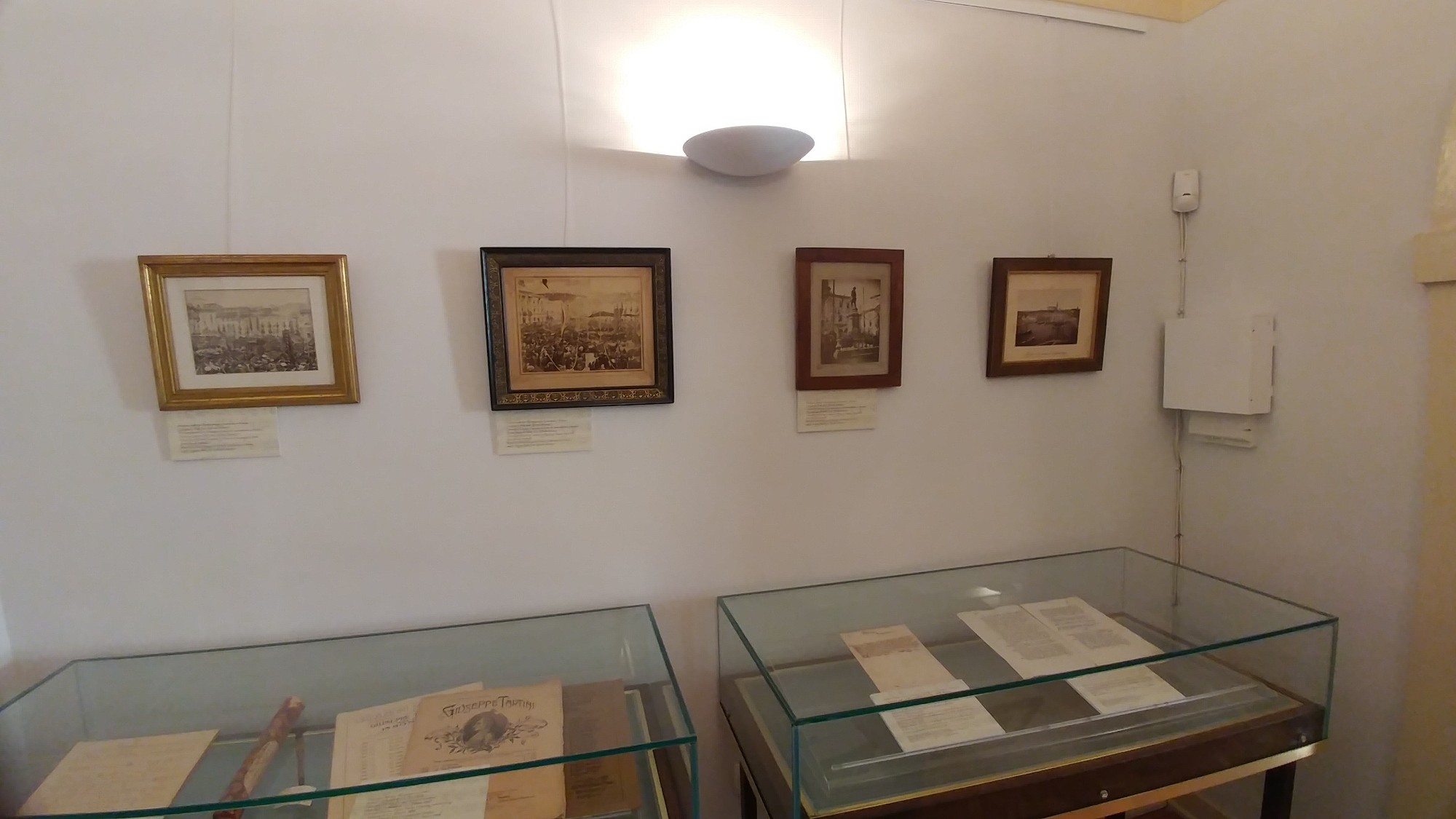One of the houses on the north side of Tartini Square, the Tartini House is an example of bourgeois architecture and forms part of the built cultural heritage. During the comprehensive conservation works between 1988 and 1992, wall paintings were uncovered and restored, frescoes primarily commissioned by Tartini’s nephew, Captain Pietro Bartolomeo Tartini.
The building stands on the site of a former fourteenth-century Gothic house, Casa Pizagrua, built by a respectable Pizagrua family of Piran, next to the Church of St Peter, and was once located on the waterfront, in Piran’s inner harbour. Since then, the house has undergone several reconstructions, and contains paintings from different historical periods. Its inner courtyard has a water cistern and a well dating from 1821, the time of the last substantial building works.
Its current neo-classical exterior originates from the 19th century.
Giuseppe Tartini Memorial Room
In memory of Giuseppe Tartini (1692–1770), a world-renowned violin virtuoso, composer, music theorist and educator, unquestionably Piran’s most prominent personality, a permanent museum collection, the Giuseppe Tartini Memorial Room managed by the “Sergej Mašera” Maritime Museum in Piran, was arranged in his birthplace in 1992.
The collection is displayed in a small room, a former bedroom – an alcove adorned with original Baroque ceiling paintings and stucco decorations and the coat-of-arms of the Tartini family. This might have been the room where Tartini was born. He was baptised on 8 April 1692 in the Baptistery of St John the Baptist next to the parish Church of St George in Piran; the date of the christening has been established as the date of his birth.
A selection of some of the most valuable specimens from Tartini’s legacy is on view in the memorial room. The central exhibit is the Tartini violin, one of the three string instruments bequeathed by Giuseppe Tartini in his will, and the only one continually kept in his native town. Initially owned by Tartini’s relatives, the violin, an invaluable item of material heritage, was subsequently safeguarded by Piran City Library, Biblioteca Civica. In 1954, the violin came under the guardianship of Piran Maritime Museum.
The violin was made in the first decades of the 18th century by Dom Nicolò Marchioni of Bologna, who assumed the pseudonym Amati as a homage to the Amatis, a renowned violin-making family based in Cremona, thus denominating his violin-making profession. The authenticity of the Tartini violin was confirmed in 1937 in Cremona. The certificate of authenticity issued on that occasion now forms part of the museum collection. A period instrument of exceptional quality, the violin sustained some damage throughout its history, and had to be restored on several occasions. The restoration was carried out by Maksimilijan Skalar in 1954, Vilim Demšar in 1991 and László Lakatos in 2005. In 2016, the violin was entrusted to the care of Bruce Carlson from Cremona, who is also the curator of the Paganini violin kept in Genoa. Over the past twenty years, the Tartini violin, an excellent and well-matured historic instrument, has been played by several distinguished violinists, including Anja Bukovec, Nadezda Tokareva, and Črtomir Šiškovič, who released an album of Tartini’s Sonate za violino in generalni bas (Sonatas for Violin and Basso Continuo) played on this instrument. The Tartini violin is also an attraction for international musicians taking part in the Tartini Festival: violinists from all around the world come to his birthplace to play it.
The memorial room displays the only original representations of the great violinist: his death mask in plaster cast, his portrait – an oil on canvas made by an unknown artist in the late 19th century, a marble bust from 1846 made by Venetian sculptor Francesco Bosa (1803–1870), and his likeness in a graphic print: a portrait on the cover of a small book, Nagrobni govor opata Francesca Fanzage (The Funeral Oration by Abbott Francesco Fanzaga), published on 18 February 1770 in Padua, which is the most inventive depiction of Tartini. Another visual artwork on show is a graphic print by James Marshall, a representation of Tartini’s dream illustrating his most famous sonata, The Devil’s Trill.
All the featured Tartini’s manuscripts are of inestimable value: his geometric and mathematical theories of the circle and discourses on music theory. The exhibits include the first publication in book form of Tartini’s treatises on music and the principles of music harmony, Disquisizione sulla musica e sui principi dell’armonia in musica, which was published in Padua in 1754. Owned by the Regional Archives Koper, the Piran Branch, the written materials form part of the Giuseppe Tartini Collection, whose archival catalogue has been published in printed format. The Koper Archives also hold Tartini’s letter to a famous violinist, his pupil Maddalena Lombardini, in which Tartini succinctly explains the principles of violin bowing technique. The letter constitutes a unique historic example of violin instruction by correspondence.
The museum shop offers a wide selection of CDs, books, pictorial reproductions, postcards, bookmarks, magnets, etc.
Duška Žitko, Museum Councillor, Head Curator
Giuseppe Tartini
Piran-born violin virtuoso and music theorist Giuseppe Tartini (1692–1770) was a composer of late baroque and early classicism. Working most of his life in the Republic of Venice, mainly in Padua, his legacy – particularly the family documents and theoretical writings kept in his birthplace – bears testimony to the composer’s early period in his native town.
Tartini’s father, Giovanni Antonio, was the director of the Piran saltpans and intended his son to become a friar. To this end, Tartini received a musical training in Piran and was later enrolled in the Collegio dei padri delle scuole Pie in Koper/Capodistria, where he also took instruction in humanities and rhetoric. He left his native town in 1708 never to return, although the land and the specific features of its music folklore purportedly – according to references found in some of his writings – made a lasting impression on him. Tartini studied law at Padua, and at the same time established a reputation as a fencer.
After his father’s death in 1710, he married Elisabetta Premazore, a woman who would have incurred his father’s disapproval, because of her lower social class and age difference. In marrying Elisabetta, Tartini offended the sentiments of the powerful Cardinal Giorgio Cornaro, and consequently took refuge at Assisi. In the St Francis Monastery, Tartini enjoyed the protection of Father Torre, a kinsman from Piran, and after his death, supported himself as a musician. We learn from his Trattato di musica (Treatise on Music) that he was in the orchestra of the Ancona Opera in 1714. He claimed that it had been then that he discovered the acoustic phenomenon of terzo suono, or the combination tone. The discovery was to play an essential role in his theories and influenced his composing and violin technique. While Tartini’s relatively idiosyncratic mathematical ideas made only a marginal impact at the time, his findings in physics later laid a foundation for contemporary acoustics.
Tartini held concerts at Parma (1728), Bologna (1730), Camerino (1735), Ferrara (1739) and, particularly, Venice. He established a violin school in Padua, which attracted students from all over Europe, and Tartini was dubbed ‘a maestro (teacher) of nations’. His school focused intensively on establishing a modern style of violin bowing, introducing techniques that enabled the performance of Tartini’s innovative music style. Besides violin playing, Tartini taught composition.
The first notable owner of a Stradivarius violin, Tartini later presented it to one of his talented students, Mazzurani, who gave it to a Polish composer and violinist, Karol Lipiński (the instrument is today known as the Lipinski Stradivarius).
Tartini’s extensive music creativity is marked by two instrumental genres, solo works for violin (concerti) and violin sonatas. His instrumental output, amounting to approximately 130 concerti and over 180 chamber works, is complemented by an oeuvre of around 20 religious vocal pieces. Tartini’s style reflects the marked influence of Arcangelo Corelli.
The genesis of Tartini’s foremost violin sonata in G minor, Trillo del Diavolo (Devil’s Trill), is surrounded by an aura of mysticism. Tartini wrote the piece after waking from a particularly vivid dream of the Devil – with whom he had made a pact for his soul – playing a violin with breath-taking virtuosity.
Maia Juvanc
